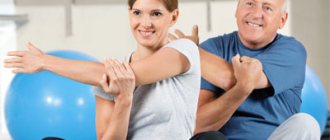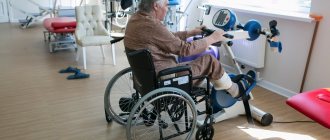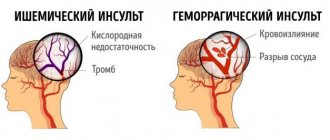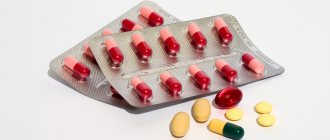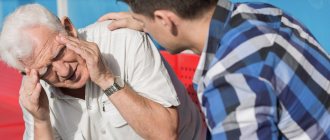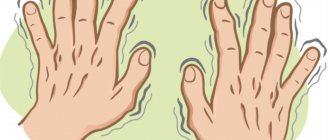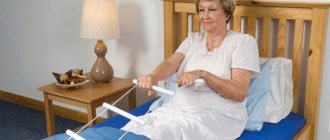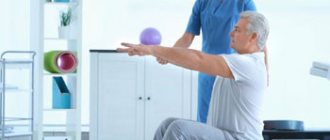Issues discussed in the material:
- What are the consequences of different types of strokes in older people?
- What are the main areas of rehabilitation of an elderly person after a stroke that need to be covered?
- How quickly will an elderly person recover from a stroke, and what affects this period?
The recovery of an elderly patient after a cerebral hemorrhage depends on many factors. But the main thing during the recovery period is complete care and proper rehabilitation after a stroke in an elderly person. Otherwise, the outcome of the disease can result in severe complications - from loss of motor functions to mental illness and even death.
Rehabilitation after a stroke in an elderly person and recovery time
We recommend
“How to communicate with elderly parents so that everyone feels comfortable” Read more
Rehabilitation after a stroke in an elderly person should be complete; it is extremely important to make every effort so that the patient returns to a full life as soon as possible. For a quick recovery, it is best to undergo rehabilitation in specialized institutions where comprehensive treatment will be prescribed. Of course, recovery will take a lot of time; each case of the disease is individual. Some will take years, while others will get back on their feet in just a few months.
There are three stages of rehabilitation after a stroke in an elderly person:
- Early rehabilitation (six months).
- Late recovery (from 6 months to a year).
- Residual rehabilitation (at least a year has passed since the stroke).
During the first three months, the strength and functions of the affected part of the body are restored. The success and effectiveness of rehabilitation after a stroke in an elderly person largely depends on timely and competent treatment. According to doctors, the most important period of recovery is the first year.
The first six months are a favorable time for the rehabilitation of speech and motor functions after an attack. Many families place relatives after a cerebral hemorrhage in specialized boarding houses. This is explained by the fact that for effective treatment and recovery of the patient, the person caring for him must have at least primary skills and basic knowledge. Otherwise, the end result may be unsatisfactory.
In the first few days, the patient must be protected from any negativity and a favorable microclimate must be created. It is very important to talk to an older person and share good news.
The recovery period takes a long time, during which the patient undergoes complex treatment:
We recommend
“Adaptation of older people: in modern society and boarding homes” More details
1. Taking medications.
2. Physical activity:
- restorative gymnastics and physical education;
- massage treatments;
- physiotherapeutic manipulations (electrophoresis, healing baths, magnetic therapy).
3. Psychological support:
- a course with a psychologist;
- restoration of everyday and social skills;
- communication with other people.
4. Following a special diet - avoiding fried, fatty, spicy foods, alcohol, coffee. It is recommended to consume more foods rich in beneficial vitamins and microelements that stimulate the functioning of the brain and the body as a whole.
5. Restoration of the speech apparatus, logical thinking and memory:
- a course of lessons with a speech therapist;
- solving problems and puzzles;
- singing and reading lessons.
6. Rehabilitation of the musculoskeletal system:
- gymnastics, training on simulators;
- visiting the swimming pool;
- walking.
Throughout the entire course of rehabilitation with an elderly person after a stroke, relatives should be nearby; their goal is to surround the patient with love and care. For an elderly patient, this is the best medicine, giving strength and vigor for a speedy recovery and restoration of lost functions.
Recommended articles on this topic:
- Features of older people: psychological and physiological
- The main problems of older people and ways to solve them
- Boarding home for the elderly: features and rules of choice
Rules for bed rest after a stroke in an elderly person
After an attack, a person is hospitalized, so it is important to familiarize yourself with the definition of bed rest. It doesn’t matter at all with what severity of stroke the elderly person was admitted to the hospital - in the first few weeks, and sometimes even months, it is extremely important to lie down more time and reduce any bodily movements to a minimum.
After an ischemic stroke, the most common, unilateral damage is possible, in particular paralysis. The main thing is not to panic and convince the victim that with a reasonable approach to the problem and proper treatment, the lost functions will quickly be restored.
Hospital treatment and rehabilitation after a stroke in an elderly person implies compliance with important rules:
- Under no circumstances should the patient remain in one position for a long time; this is dangerous due to the appearance of bedsores, which will greatly complicate rehabilitation.
- It is necessary to turn the patient over regularly; experts recommend doing this approximately once every two to three hours.
- To restore motor skills and complete recovery, it is important to do therapeutic exercises.
- It is necessary to maintain correct body position.
Please note that an elderly patient will spend a long time in a supine position. Therefore, it is important to provide him with comfortable conditions for the shoulder joints, so that their mobility is preserved. Otherwise, soon the soft tissues and joints will begin to numb, and the elderly person will experience pain in these areas.
In a supine position, the injured arm should be at an elevated level. It is best to use a pillow or cushion for this. You can achieve the maximum effect by placing a small salt bag weighing up to 500 grams. The visible result from the above manipulations should be as follows:
- An elderly patient's arm does not bend at the elbow.
- Keeping your fingers aligned is especially important.
- The distance between the torso and shoulder should be the same and unchanged.
Pay attention to the rules of leg position during primary rehabilitation after a stroke in an elderly person:
- A special cushion should be placed under the legs of an elderly patient. This way you will achieve the desired elevation angle of 15–20 degrees, necessary for proper blood supply.
- There are also special foot rests. When using such a device, you need to check that it is in the neutral position.
Important note: for the patient to be in the correct position, both legs - both the injured and the healthy ones - must lie equally.
Following these rules is vital for proper rehabilitation after a stroke in an elderly person.
If the patient is lying on his side, other recommendations must be followed. Due to the fact that after hemorrhage only one side is paralyzed, the victim must lie in two positions - on the healthy side and on the sick one.
If an elderly patient is lying on the healthy side, place a support under the limbs and a pillow under the sore side. Pre-bend the non-working joints.
If an elderly patient is lying on the paralyzed side, you need to tilt his head down, but not too much. The paralyzed arm must be straightened and the palm placed on the body. In this position, the injured arm should be bent at a right angle, and the healthy arm should be pulled back.
We recommend
“Examination of an elderly person - which doctors should be seen regularly” Read more
Speech rehabilitation after a stroke in an elderly person
After an attack, an elderly patient may lose his previous ability to speak. This is a big blow to the mental health of any of us, and even more so for an elderly person. If such problems do affect you, they must be eliminated as soon as possible.
Rehabilitation after a stroke at this phase requires special actions. Speech pathologies (aphasia) are divided into several types:
- Motor type speech disorder.
An elderly person hears and understands well the speech of others, but due to severe damage to the speech centers, he cannot independently express his thoughts in words.
- Speech disorder of sensory type.
A serious pathology arising from damage to Wernicke's center. An elderly person hears and repeats words, but does not understand their meaning.
Rehabilitation of speech functions must be quick and competent; due to the inability to express their thoughts, an elderly person’s psyche suffers and their moral state deteriorates. It is important that relatives or medical workers should be the first to take the initiative in communication.
For the best effect from the rehabilitation of speech skills, caregivers or loved ones must follow the main rules:
- An elderly patient cannot be left alone and isolated from people; communication must be constant.
- If the patient cannot finish a phrase or word due to damage to the speech center, you cannot help and finish speaking for him. At the same time, you must focus all your attention on what he is saying.
- In especially severe cases, it is recommended to learn to express thoughts with gestures or other communication methods.
- It is necessary to perform exercises for the muscles of the tongue together with the patient.
- For rehabilitation of an elderly person after a stroke, it is very important to find constant contact with the patient and maintain a dialogue on any topic that interests him.
It is ideal if you seek professional help from a speech therapist-aphasiologist. All rehabilitation should take place under his leadership.
Clinical classification of strokes
Ischemic stroke (cerebral infarction)
A cerebral infarction, like a heart attack, occurs as a result of complete blockage of the vascular bed. The part of the brain that was fed by this vessel dies. The consequences of an ischemic stroke, namely the likelihood of survival and recovery, depend on which vessel was damaged. The larger the vessel, the more of the brain will be damaged.
Ischemic stroke occurs as a result of:
- a blood clot enters the brain and completely blocks the vessel;
- cessation of blood flow in a vessel due to damage to the vessel by atherosclerosis.
Hemorrhagic stroke (intracerebral hemorrhage)
As a result of a ruptured vessel, brain tissue becomes saturated with blood and dies, and the resulting hematomas put pressure on healthy areas of the brain, impairing blood circulation. As with cerebral infarction, the severity of a patient with a hemorrhagic stroke depends on the area and extent of the brain damage.
The most common causes of hemorrhagic stroke are:
- cerebral aneurysms;
- uncontrolled high blood pressure;
- atherosclerotic vascular damage.
If you suspect a stroke, it is very important to go to the hospital as quickly as possible. As a result of the passive flow of fluid to damaged tissues, a very dangerous complication develops - cerebral edema.
Restoration of motor functions
We recommend
“Private boarding house for the elderly: selection criteria and registration procedure” More details
Wherever rehabilitation after a stroke takes place in an elderly person - at home or in a boarding house - the priority should be the restoration of all lost functions. Sometimes it happens that full regeneration may not occur. For this reason, the recovery period of motor functions can be divided into two groups:
- Complete – complete rehabilitation of all lost abilities of the body.
- Compensation for lost abilities if full recovery is impossible. A sick elderly person should receive at least the necessary minimum of household skills.
Even if complete rehabilitation does not help restore lost skills, you need to follow a full list of recommendations, exercises and undergo comprehensive treatment. Under no circumstances should you refuse a full recovery.
The rehabilitation process during this period should consist of several stages. In the first days and weeks, it will be enough to perform simple exercises without excessive physical activity. Later, the elderly patient will try to complete assigned tasks independently. The caregiver should assist the patient only in difficult cases.
After this stage, rehabilitation of motor functions begins. The first is imitation of steps, without getting out of bed. Next, you need to help the elderly person get up and just stand in one place for a while. You can use improvised objects as support: chairs, headboards. After an attack, a person must begin to walk again on his own, with a little help from a caregiver.
The most difficult task is to restore the motor abilities of the hands. This is due to the fact that many damaged brain cells are responsible for this function. But be that as it may, this temporarily lost ability can still be restored if the problem is addressed as soon as possible. It is important to realize that the process of rehabilitation after a stroke of an elderly person is a long and labor-intensive task, but effective.
You can immobilize the healthy arm for several hours so that the elderly patient tries to serve himself only with the affected arm. For example, he held a spoon, typed on the computer, washed his face.
Pre-stroke symptoms and signs of stroke
Elderly people often complain of general malaise and weakness. If typical symptoms are accompanied by additional signs of an unhealthy condition, measures need to be taken, because these may be harbingers of a pre-stroke condition.
Signs of a pre-stroke condition in the elderly:
- painful sensations in the cardiac region periodically occur, which soon become permanent;
- feeling of numbness of the face and limbs;
- dry mouth;
- dizziness;
- difficulty breathing;
- feeling your own heartbeat.
Visually, these symptoms may remain invisible to the family, but if you maintain a trusting relationship with the old man, he will definitely share his unpleasant sensations, by which the risks of a stroke can be recognized.
If there is an acute disruption of the blood supply to the brain, the symptoms become more pronounced.
Common signs of a stroke:
- sharp pain in the head;
- urge to vomit;
- impaired coordination of movements;
- slurred speech, like a drunk person;
- hoarseness of voice;
- disorientation in space;
- distorted face, asymmetrical smile;
- fainting.
During an attack of a stroke, an elderly person’s blood pressure may rise greatly or, conversely, drop to very low levels. You can't hesitate! You need to call an ambulance, because a stroke can have extremely adverse consequences for a person’s health, including sudden death.
Nutrition and swallowing rehabilitation
We recommend
“Centers for pensioners: what they are and how to get there” Read more
Sometimes, as a result of an attack, people can feel the taste and amount of food in only one half of the mouth. An elderly patient will have to relearn how to chew and swallow. There is a special set of exercises to restore the swallowing reflex:
- Imitation of swallowing movements.
- Imitation of yawning, while it is important to open your mouth as wide as possible.
- Gargling with plain water.
- Imitation of cough.
- Puff out your cheeks and hold your breath in this position for a few seconds.
- Pronouncing the sound “i” and tapping the larynx at this time.
During rehabilitation after a stroke, staff and loved ones of the patient must comply with basic nutritional requirements. Damage after illness can also affect the body's ability to take in and digest food. Therefore, it is important to provide the victim with proper nutrition and feed him independently. The elderly patient himself will not be able to even bring food to his mouth, and sometimes this can be very dangerous.
Food can only be served from the working side; its consistency must be soft!
Make sure the older person has time to chew and swallow a portion before giving him another.
Check the temperature of the food, do not give too hot or cold food, this can lead to spasms and cramps of the esophagus.
The main thing in the diet of an elderly person who has suffered a stroke is to follow a diet, the principles of which are to exclude or consume very small amounts of animal fat and salt.
Partial abstinence from animal fats helps lower cholesterol in the blood, and this will help avoid a recurrent attack. Reducing the amount of salt consumed normalizes blood pressure. When it is normal, the restoration of body functions after a hemorrhage is more effective and faster, and further damage to brain neurons is prevented. Another important effect of proper nutrition is weight loss.
We recommend
“A set of exercises for older people: body and breathing” Read more
Other methods of rehabilitation after a stroke in an elderly person
1. Rehabilitation with the help of drugs.
This type of recovery is based on the use of various manipulations and injections that regenerate the lost capabilities of the human brain. Medicines prescribed after hemorrhage work to improve blood flow through the vessels of the brain (nootropic drugs). They also have a positive effect on the metabolism in brain neurons and on the analytical and synthetic work of the cerebral cortex.
2. Massage.
Massage for rehabilitation after a stroke of an elderly person consists of several stages: the patient is placed on his back, the paralyzed arm is moved to the side and fixed at the level of the shoulder joint. It is important that the hand and forearm are extended. Next, carefully massage all the folds, joints of the fingers, hands, and elbows. Movements should be slow and careful, without causing pain or tone.
The injured leg should be massaged in the same way as the arm. You need to place a pillow or a towel cushion under your knee.
3. Special simulators.
Fortunately, in modern stores you can find any auxiliary simulators for restoring motor skills. They help rehabilitate an elderly person at home or in a boarding house, even if he is unable to get out of bed. The operating principle of such devices is as follows: training damaged or paralyzed limbs that lack sensitivity. With the help of special devices, you can develop joints, activate the functioning of nerve endings and return the body to its previous healthy state.
The visible effect of rehabilitation after a stroke in an elderly person is provided by such simulators as:
- step trainer;
- bars for pull-ups (for working the muscles and joints of the arms and forearms);
- a hill for climbing and walking;
- weighted walking bars.
Only the doctor determines the set of necessary exercises, their duration and intensity.
4. Therapeutic physical education (physical therapy).
Today, there are many different methods for rehabilitation after a stroke of an elderly person. Exercise therapy is recognized as the most effective of them.
The set of exercises necessary for an elderly patient is selected individually. Among them may be:
1. Passive exercises. They should be performed with the help of a medical professional or a trained loved one:
- massage treatments;
- flexion of the joints of the legs and arms;
- raising and lowering limbs;
- fist clenching.
2. Exercises on a chair - suitable for patients who can sit:
- rotations and tilts of the head;
- imitation of the grasping function - clenching and unclenching a fist;
- special breathing exercises with squeezing and spreading of the shoulder blades.
3. Exercises in a standing position:
- hands rise up as you inhale and fall down as you exhale;
- a game involving a tennis ball, arms extended forward, fingers closed.
- alternately raising and lowering your legs on the chair seat;
- standing on tiptoes.
We recommend
“Gymnastics for the elderly: the best exercises for various diseases” Read more
Signs of stroke in older people
Elderly and senile people are characterized by a gradual increase in symptoms, so contacting a doctor is mandatory even at the slightest suspicion of a stroke.
Symptoms of a stroke are:
- complete or partial loss of the ability to move voluntarily in one leg and arm;
- Lack of skin sensitivity on one half of the body;
- blindness in half of the visual field;
- partial or complete loss of speech;
- loss of ability to write clearly;
- loss of ability to perceive written information;
- the patient's denial of his condition;
- impaired eye movement;
- dizziness;
- nausea;
- vomit.
Prevention of recurrent stroke
To prevent stroke and re-stroke, the following prevention recommendations should be followed:
- Pay attention to blood pressure; high levels often cause cerebral hemorrhage.
- If you suffer from hypertension, consult your doctor and choose the appropriate medication. For a better effect of normalizing blood pressure, you can combine taking pills with moderate exercise.
- Spend more time outdoors, walk more often slowly.
- Give up bad habits, they are the main cause of an attack.
- Watch your weight. Excess weight increases the risk of stroke.
- Try to find positive moments, reasons to laugh, be happy, and do what you love.
Prevention
Prevention should be aimed at identifying and correcting the main risk factors.
Atherosclerosis
It is necessary to constantly monitor the level of blood lipids - total cholesterol, LDL, HDL, VLDL, TG, CA. If you are prone to high cholesterol, you must follow the prescribed diet. If following a diet does not provide the desired reduction in cholesterol levels, statins are prescribed - drugs that lower blood lipid levels.
Arterial hypertension
If a diagnosis of “Arterial hypertension” is made, you should take all prescribed medications without skipping, even with normal blood pressure values. You need to keep a blood pressure diary, where you should enter your blood pressure and pulse readings. If blood pressure is unstable, there is a tendency to crises, the diary should be filled out 2 times a day - morning and evening. Such a diary will help the doctor choose the optimal therapy.
Rhythm disorders
Rhythm disturbances can be the result of many heart diseases, incl. myocardial infarction. If there are rhythm disturbances in the atria, most often atrial fibrillation, a person may not feel anything; these disturbances can be detected by taking an ECG. Atrial fibrillation causes the formation of thrombi - blood clots that can cause not only strokes, but also heart attacks of other internal organs.
If atrial fibrillation is detected, anticoagulants are prescribed - drugs that prevent thrombus formation. Taking anticoagulants increases the risk of bleeding. Anticoagulants should not be interrupted, and the drug or dose should not be changed without the doctor's permission.
When PMI or stroke occurs in people under 45 years of age without cardiovascular disease, rarer causes should be excluded.
Stroke is easier to prevent than to treat its consequences. In severe cases, patients remain bedridden despite all the efforts of doctors and relatives. In other cases, rehabilitation can take months or years. The network of boarding houses has created special programs for recovery after a stroke in boarding houses, which are aimed at speedy recovery under the supervision of specialists.
